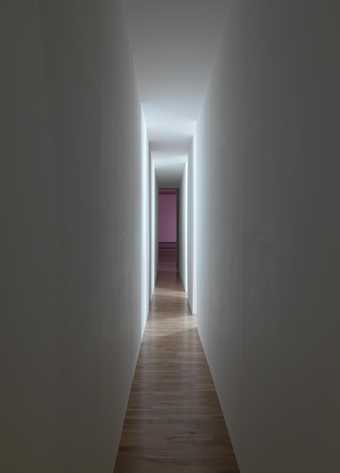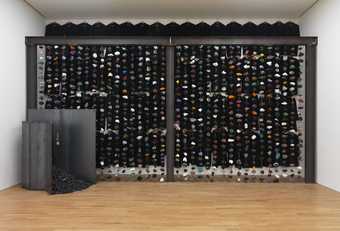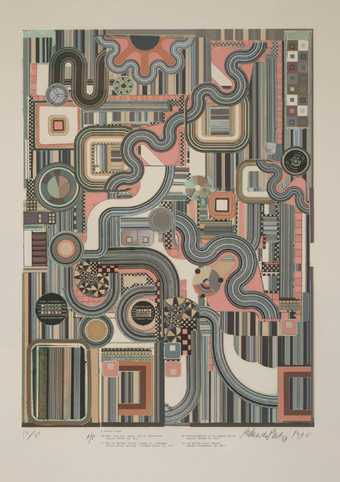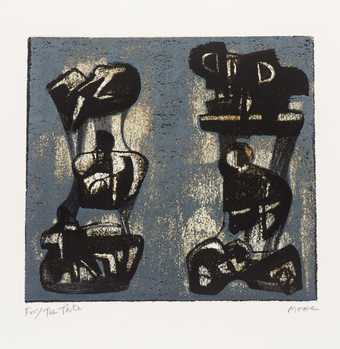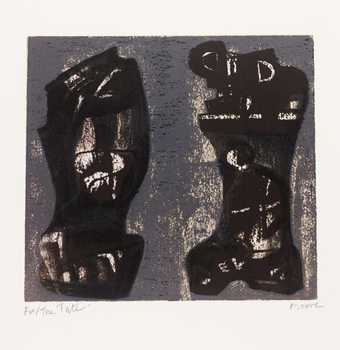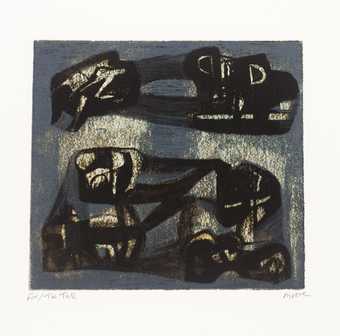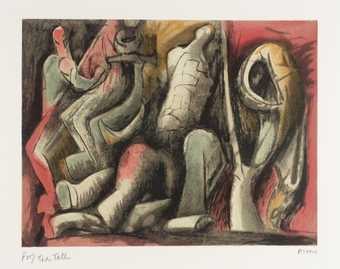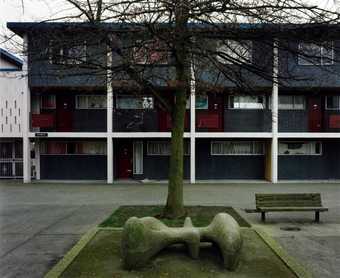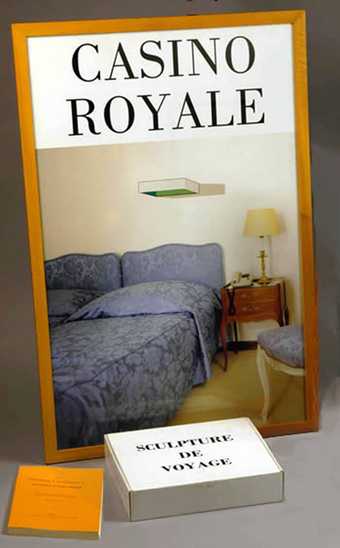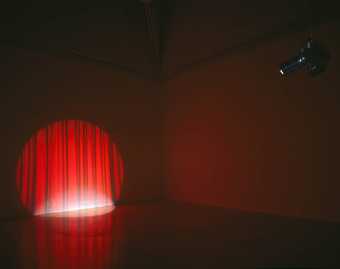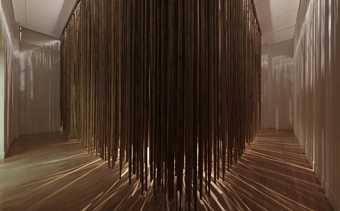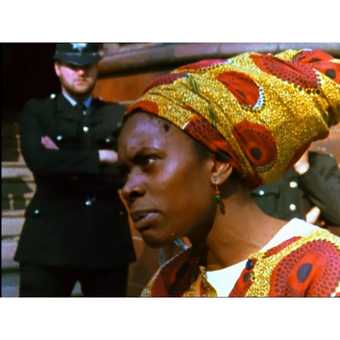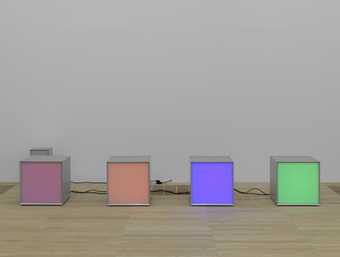Not on display
- Artist
- Angela Bulloch born 1966
- Medium
- 4 belisha beacons, 4 light bulbs and light control unit
- Dimensions
- Displayed: 1660 × 3000 mm
- Collection
- Tate
- Acquisition
- Purchased 2006
- Reference
- T12307
Summary
West Ham – Sculpture for Football Songs is a sculptural installation comprising a set of four translucent plastic spheres that are arranged in a row on the wall, each containing a coloured light bulb. The spheres all measure 300 mm in diameter and are each arranged at exactly the same distance from the floor, with gaps of 600 mm between them as measured from each sphere’s centre. Two of the bulbs in the spheres are blue and two are a claret-red colour, and these occupy the spheres in an alternating pattern: the bulb on the far left is blue, the next is red, the next blue and the final bulb red. Only one bulb is illuminated at any one time and they light up for varying durations in a sequence that runs from left to right in a constant loop. The durations for which the lights are switched on is determined by whether or not a microphone that is placed in the room can detect any sound: when the microphone picks up no sound, each bulb remains lit for around eight to twelve seconds, but when it does detect a noise these periods of illumination are much shorter. Each sphere is attached to a plastic ring that is in turn held onto the wall by a supporting bracket. A visible cable connects the lights to the mechanism that turns them on and off, and this cable is not fixed to the wall or the floor but rather is threaded through a small hole in the bottom of each sphere.
This work was made in 1998 by the British artist Angela Bulloch. It was originally produced for an exhibition entitled Codes that was held at Schipper and Krome Gallery in Berlin during the same year. Although no definite account exists of the making of West Ham – Sculpture for Football Songs, Bulloch has stated that when creating sculptures involving electrical devices she has usually worked with fabricators. Nonetheless, she has insisted that she is always involved in every stage of a work’s production, noting that decisions are made throughout the process of fabrication, rather than each creative choice being settled on in earlier planning stages (Bussel 1997, p.31).
The plastic spheres that Bulloch used in this work and a number of others from the same period are Belisha beacons – the amber globes mounted on black poles that mark pedestrian crossings in Bulloch’s native United Kingdom, as well as in other countries. Bulloch stated in 1997 that she used these objects because she was interested in changing their meaning ‘by shifting this basic language of flashing lights into another context’ (Bulloch in Bussel 1997, p.31). In West Ham – Sculpture for Football Songs, she has used the beacons to display the claret and blue colours of the kit worn by players for the east London-based West Ham Football Club. This partly explains the work’s title, and it seems likely that Bulloch might have chosen to link the piece with ‘football songs’ because, like these songs, this sculpture has a rhythmic aspect.
West Ham – Sculpture for Football Songs is one of many works by Bulloch that are activated or altered in some way by the presence of gallery visitors. In 1997 the artist stated that she is interested in acknowledging the viewer’s role as an active participant in co-producing her works, saying that in her practice
The viewer is a collaborator in the sense that she defines, perceives the meaning in her own terms. This would happen anyway with any work, provided there is a viewer. What I try to do is make the fact of interpretation, understanding or perceiving part of purpose of the work itself.
(Bulloch in Bussel 1997, p.31.)
However, Bulloch explained further that her installation works are designed to suggest ‘that one’s individual choices are more or less meaningless, because the system or structure has already defined the parameters of choice, even if they seem elective … The viewer is already framed within the work, whether one likes it or not’ (Bulloch in Bussel 1997, p.31). This idea of an apparent freedom that is in fact governed by rules is perhaps also suggested through Bulloch’s use of Belisha beacons, which designate specific places where pedestrians have right of way to cross the road.
Bulloch has often made use of electronic technologies in her practice, acknowledging that many of her installations from the mid- to late 1990s have a ‘gadget quality’ to them (Bulloch in Bussel 1997, p.34). However, Bulloch has insisted that she is not interested in technology for its own sake, but rather the ways in which people ‘interface’ with it and ‘what psychological effect this has’ (Bulloch in Bussel 1997, p.34).
Further reading
David Bussel, ‘Who Controls What? Interview with Angela Bulloch’, in Art from the UK, exhibition catalogue, Sammlung Goetz, Munich 1997, pp.31–6.
Andrew Wilson, ‘Maybe’, Parkett, no.66, 2002, pp.36–7.
Prime Numbers: Angela Bulloch, exhibition catalogue, Secession Vienna, Vienna 2005.
David Hodge
October 2014
Supported by Christie’s.
Does this text contain inaccurate information or language that you feel we should improve or change? We would like to hear from you.
Display caption
Bulloch has made a number of works using Belisha beacons, which are more commonly used to illuminate pedestrian crossings. Here they are linked to a microphone in the gallery space and respond to sound, which initiates a sequence of flashing lights. The colours of the lights reflect the colours of the West Ham football strip, and the work’s title suggests that football anthems are a particularly appropriate trigger to speed up the light display. The unpredictable interactive element of this work is typical of Bulloch’s practice.
Gallery label, December 2006
Does this text contain inaccurate information or language that you feel we should improve or change? We would like to hear from you.
Explore
- abstraction(8,615)
-
- non-representational(6,161)
-
- colour(2,481)
- formal qualities(12,454)
You might like
-
Bruce Nauman Changing Light Corridor with Rooms
1971 -
Jannis Kounellis Coal Sculpture with Wall of Coloured Glass
1990–2005 -
Sir Eduardo Paolozzi Four German Songs
1974–6 -
Henry Moore OM, CH Ideas for Metal Sculpture II
1981 -
Henry Moore OM, CH Ideas for Metal Sculpture V
1981 -
Henry Moore OM, CH Ideas for Metal Sculpture VI
1981 -
Henry Moore OM, CH Four Ideas for Sculpture
1982, published 1984 -
Stan Douglas Biomorphic Sculpture at McLean Park
1998 -
Stephen Willats Visual Field Automatic No.1
1964 -
Rodney Graham Casino Royale (Sculpture de Voyage)
1990 -
Ceal Floyer Double Act
2006 -
Vong Phaophanit What Falls to the Ground but Can’t Be Eaten
1991 -
Black Audio Film Collective (John Akomfrah; Reece Auguiste; Edward George; Lina Gopaul; Avril Johnson; David Lawson; Trevor Mathison) Handsworth Songs
1986 -
Angela Bulloch Aluminium 4
2012


